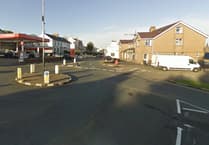A report into the incident that led to operator Van Air Europe losing its route licences has blamed poor crew training and management shortcomings.
The flight had left Ronaldsway for Belfast, on February 23, last year, the day Storm Doris hit the island and Northern Ireland.
It had to turn back and return the island, landing on Runway 26 at 9.27am.
While Citywing operated as the ticket agent, the aircraft, a Let L-410, was owned by Van Air Europe, registered in the Czech Republic.
The plane had two crew and three passengers on board.
The report by the UK’s Air Accidents Investigation Branch (AAIB, published last month, said: ’The prime causal factor in this serious incident was the decision to land with a maximum crosswind component of 40kt (46mph), which is approximately twice the maximum demonstrated certification of 19.4kt (22mph).’
threat
Analysis of the cockpit voice recorder (CVR) concluded that the crew didn’t discuss the evolving threat, which the AAIB says indicated a lack of training of crew resource management, in particular threat management.
The company operational manual also appeared to lack clear guidance in respect to problem solving and decision making.
This became further obvious as the landing approach was unstable but the crew doesn’t discuss this as would be normal standard operational procedure.
The aircraft also exceeded the limiting airspeed for flight with gear down and flaps extended, however this wasn’t corrected either.
Finally, the crew began taxiing in a wind, which was stronger than wind which blew a ’similar aircraft onto its wing tip at Isle of Man in 2007 and which exceeded the ground operation limit introduced after the 2007 accident’.
The AAIB also stated that insufficient weather information did not allow the crew to assess the storm’s path, the operational flight plan (OFP) did not account for the correct level of contingency fuel and this meant the crew ’did not allow for a realistic alternate routing’.
The plane was reported by witnesses as unstable and tilting to the left, bringing the wing tip close to the runway before it touched down.
The aircraft was then seen by eyewitnesses from the airport’s fire service who had been placed on standby, that after about travelling along the runway for about 20 metres, the plane rolled again and the wing came within one metre of the runway.
The airport fire crew had been placed on alert by air traffic control due to concern for the safety of the aircraft and occupants following the 2007 accident featuring the ’same operator’ and ’similar aircraft’.
Following a direction from the Isle of Man Civil Aviation Administration to air traffic control, the permission to taxi was withdrawn and the aircraft was halted facing into the wind with cover provided by fire engines.
The AAIB report says the order for the ’aircraft to cease taxiing may be unusual, it was apparently made with the aim of preventing an accident’, a decision the report says was with the 2007 accident in mind.
In the report, it states the co-pilot, commented ’too much roll’, despite this, the pilot later said ’he had no concern that the wing tip or the propeller might have been close to the ground’.
The report recommended improvements to the aircraft operator’s safety actions and an acknowledgement from the CAA of the Czech Republic that there has been a focus on hazard identification and safety risk management, particularly in bad weather.
Following this incident, Citywing ceased trading in March 2017, explaining that the decision to end Van Air’s licences had led to ’considerable losses’ that had proved unsustainable.
manx2
The company started as Manx2 before becoming Citywing in 2012 following a management buyout, each operated as a ’virtual airline’, meaning the company only sold the tickets but doesn’t actually own or operate any aircraft, but subcontracts other airlines to operate flights.




